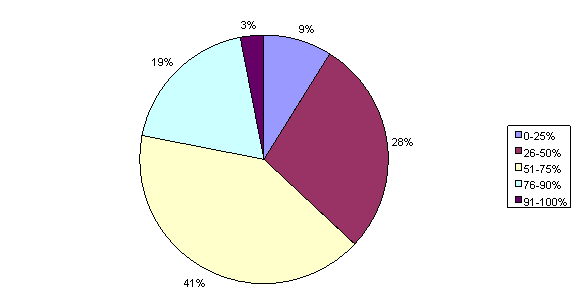What kinds of changes or adaptations have news organizations begun to make to the content as an online, 24-hour-a-day, seven-day-a-week product?
Most still rely most heavily on their original reporting. Fully 89% of news executives name it as the type of information most important to their brand. But, in the age of the Internet, even original reporting can often be duplicative. Two-thirds of broadcast executives acknowledge that less than half of their original content is unique information not yet reported by others, including one-in-three who say that is the case for less than a quarter of their original content. Among newspapers executives, four-in-ten say that 51-75% of their original content has information not yet reported on by others.
Newspaper Organizations’ Unique Information
% of all Content

Broadcasting Organizations’ Unique Information
% of all Content

Question: “Thinking about the original content you now offer each day, what portion would you say is unique information not yet reported by others?”
The next most important element to the brands of these organizations differs somewhat by media sector and plays to the traits of each. For broadcasters, multimedia features were most likely to rank second (41%), followed by material aggregated from other legacy outlets or wires (24% ranked it second and 27% ranked it third). Print executives put higher value on original commentary offered (45% ranked it second), while most broadcast executives ranked it last among the items listed.
Most Important Types of Information for Newspaper Executives

Most Important Types of Information for Broadcast Executives

Question: “Please rank in order from 1 to 6 the importance to your brand of each type of information, where 1 represents the most important and 6 the least important. (Please use each number only once.)” These charts represent those who ranked the types of information as most important, one or two.
As a way of finding distinctive content to draw audiences, some organizations are becoming more specialized in the content they offer, especially those from a print background. Fully 76% of newspaper executives say their organization is moving in the direction of choosing to cover certain subject areas in depth and no longer covering others. This includes a quarter of them say they are moving strongly in that direction. Another 23% aren’t moving that way at all.
Broadcast organizations are mostly split with half saying they are moving toward specialized content (16% strongly so) and the other half (48%) saying they have not taken such steps.
Another trend that has yet to become widely adopted among these organizations is the growing practice of including content produced by outside news organizations or journalist groups, other than wires. Among both groups, the biggest percentage (45% combined, 49% RTDNA, 37% ASNE) has not done this at all. But a third of newspaper executives say their outlets do this “on a regular basis.” Fewer broadcasters (22%) report the regular practice. But majorities of both groups say that in general they are at least somewhat comfortable with the idea.
When organizations do run this type of content, they seem to keep control over what makes it into their brand. Nearly 60% of print executives fully edit these outside submissions, sometimes asking for additional reporting. Just 2% of all executives surveyed said they are contractually obliged to take that content verbatim.
<!–
/* Style Definitions */
p.MsoNormal, li.MsoNormal, div.MsoNormal
{mso-style-parent:””;
margin:0in;
margin-bottom:.0001pt;
mso-pagination:widow-orphan;
font-size:12.0pt;
font-family:”Times New Roman”;
mso-fareast-font-family:”Times New Roman”;}
@page Section1
{size:8.5in 11.0in;
margin:1.0in 1.25in 1.0in 1.25in;
mso-header-margin:.5in;
mso-footer-margin:.5in;
mso-paper-source:0;}
div.Section1
{page:Section1;}
–>


